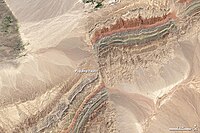
Photo from wikipedia
In one of the largest oil-gas fields in Daqing, China, the anticlines are important structures that hold natural gas. The origin of the symmetric anticlines, which have bends on both… Click to show full abstract
In one of the largest oil-gas fields in Daqing, China, the anticlines are important structures that hold natural gas. The origin of the symmetric anticlines, which have bends on both the limbs, remains under debate. This is especially true in the case of the anticline in Xujiaweizi (XJWZ), which has recently been the focus of gas exploration. A compressive force introduced by a ramp/flat fault was suggested as its origin of formation; however, this is inconsistent with the reconstruction of the regional stress fields, which show an extensive environment. An alternative explanation suggests a normal fault-related fold under extensive stress. However, this mechanism has difficulty explaining the very localized, rather than wide-spread, development of the anticline along the proposed controlling normal fault. The well-developed bends on both limbs of the anticline are also very different from the typical roll-over anticline. Here, we conduct an experimental study showing that the very localized development of the bent-on-both-limbs anticline is controlled by the geometry of the underlying fault-plane. A ramp/flat fault plane can introduce an anticline with bends on both limbs, while a smooth fault plane will develop a roll-over anticline with a bend on only one limb.
Journal Title: Scientific Reports
Year Published: 2017
Link to full text (if available)
Share on Social Media: Sign Up to like & get
recommendations!